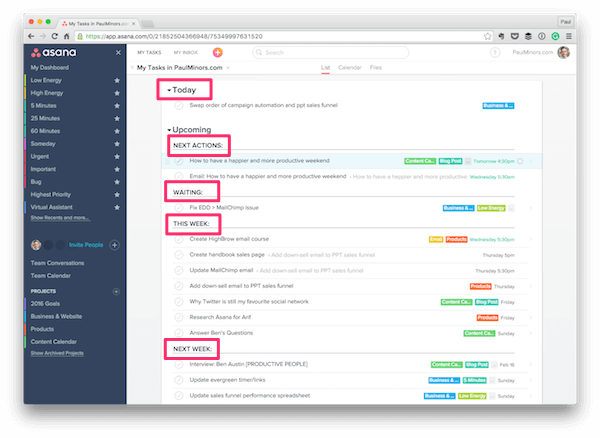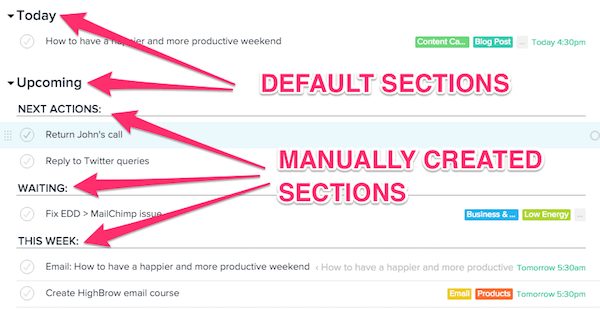Organizing Your Tasks
Episode #5 of the course How to create a productivity system by Paul Minors
Often, people make the mistake of thinking that writing down a long list of tasks is good enough. But all this does is create panic as you look at this great big list of things you need to do with no sense of what to focus on first.
In order to add structure to your task list, I recommend that you group your tasks into the following sections (don’t feel like you have to use all of them, just the ones most appropriate for you).
“Today”
This is used to group together all your tasks that you plan on doing today. When working out your daily tasks, it’s important to set yourself up for success and not plan to do too much. That’s not to say you should set your bar for success lower, but you should be realistic with how much you think you can get done on a typical day.
“Next actions”
Next actions are the smaller tasks that aren’t tied to a particular due date (because they’re less urgent). They‘re the things that you’d like to do when you get a chance. For example, if you finish your scheduled tasks for the day, you could take a look at your next actions list to see what you can tackle.
“Waiting”
When you’re waiting for something to happen or someone to respond before you can complete a task, it can be marked as “waiting.” This section is useful, as it separates the actionable tasks that you need to work on from the tasks that you’re waiting on. It’s also handy to be able to go down your waiting list and then chase up anyone you’re waiting on and ask for updates.
“This week”
These are the tasks you plan on addressing in the current week. For me, my week ends on Sunday, so anything I plan on doing on or before Sunday goes into this section. This section basically forms your weekly goals and gives you a view of everything you hope to achieve in the upcoming week.
“Next week”
These are the tasks you plan on doing during your next working week. It’s good to have these grouped together so that you can think ahead about what’s coming up in the near future. When you think of new tasks, it’s also handy to quickly move things to your next week section if you want to come back to them the following week.
“Later”
Finally, you can move any tasks to later if they’re not due for a while. Generally, anything more than a week away can go in here. This section keeps the non-urgent work out of the way and out of mind. As the tasks fall due, you can move them to next week or this week as needed.
Mistakes to avoid
The biggest mistake you can make here is to not use some sort of structure to add hierarchy to your tasks. When you organize everything into one long list, this is what leads to “overwhelm” and that feeling like you have “too much to do.”
Action step: Set up the sections above in your task list
How you do this will depend on the app that you’re using. Apps like Todoist and Asana come with “Today” and “This Week” or “Upcoming” sections by default, and the tasks automatically flow between each section as they fall due.
In Asana, tasks will automatically move between the default sections: “Later,” “Upcoming,” and “Today.” You can then manually create and organize tasks into other sections like “next actions” and “waiting.”
If your task management app doesn’t have sections like this, you can use tags, labels, or other features to categorize your tasks.
Next lesson
When you have lots going on, how do you know what to do first? Tomorrow, we’re going to look at strategies for prioritizing your work when you have lots to do.
Recommended book
“Essentialism: The Disciplined Pursuit of Less” by Greg McKeown
Share with friends



